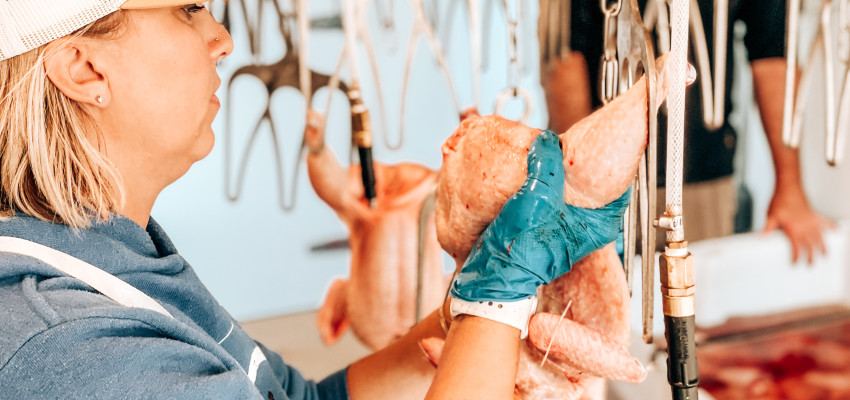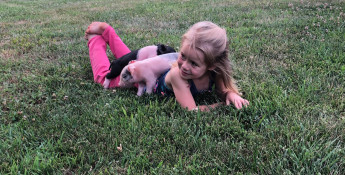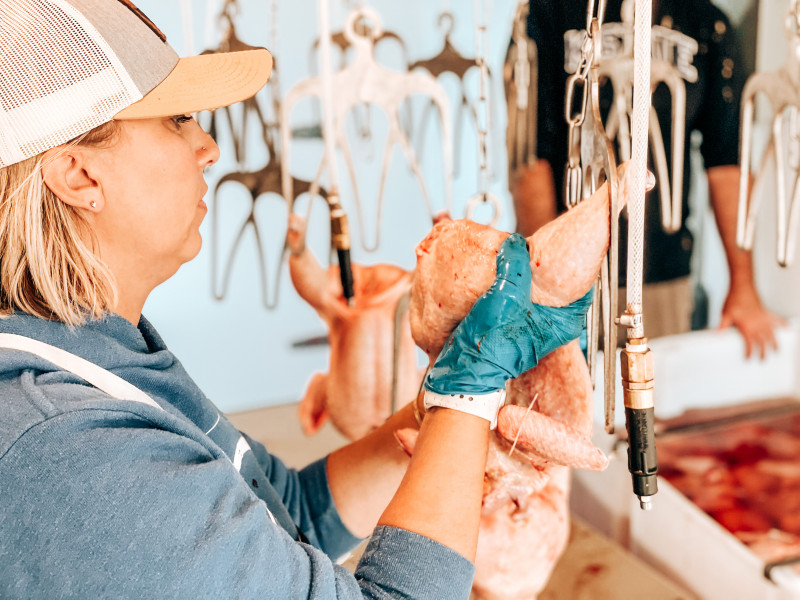By Rick McNary on January 5, 2022
Growing New Opportunities
KCK Farms innovates and adds chicken production

When Katie Carothers accepted the challenge to write and speak her dreams at a small business retreat, she knew exactly what she wanted: to expand her direct-to-consumer sales of beef, pork and chicken to restaurants wanting to buy local.
“Two weeks after I spoke my dream aloud, I got a message on Instagram from a chef in New York who was going to open the First Mile Restaurant at Bradley Faire in Wichita,” Katie says. “I almost didn’t reply because a lot of times they want cheap, wholesale prices. It turns out he was legit and was after quality meat. He was going to need 150 birds a week.”
While Katie had a buyer and knew she could raise that many birds, her challenge was getting them processed.
Here’s where the story is unique–Katie started her own processing facility on the farm she and her husband, Kregg, own near Anthony called KCK Farms, Inc. In essence, she created her own food supply chain, also known as a food system. To understand why her solutions are so unique, it helps to understand how a food system works.
The Food System
There are three basic components of a food system: production (growing the food), processing (preparing the food for human consumption) and distribution (getting the food to the plate so people can eat it).
The pandemic exposed the vulnerability of the food system when the major processing and distribution components were either shut down or significantly limited in production.
Many farmers were suddenly faced with the dilemma of what to do with their animals since they could no longer send them to major meat processors also known as meat packers. Across the nation, numerous farms faced the excruciating decision to euthanize their animals because the processing component failed. However, many pivoted and started sending animals to small, local meat processors, often called lockers, and started selling their meat products directly to consumers.
Processing Her Options
As Katie assessed her dream against the reality of a restaurant needing that many birds each week, she had two parts of the system in place: production, she could raise the birds; and distribution, she had a buyer for the birds and could deliver them herself. However, the processing component was her greatest vulnerability. Therefore, she decided to create her own food system which includes all three components.
This unique approach of having a fully integrated food system provides Katie control over the entire process.
“I want complete quality control over the process from the beginning to the end,” Katie says. “The first thing I had to do was to scale up to raise enough birds to keep that supply going. To provide 150 birds a week to a restaurant, I need to raise 800 birds at a time.”
Growing Birds
To grow 800 birds, Katie uses mobile chicken coops. She has two 20 foot by 38 foot coops that are on wheels and she moves them each day.
“I move it around the pasture which is good for the soil because the chicken poop is high in nitrogen which the soil loves,” she says. “It has an auto feed and watering system, and the chickens eat the cover crops we plant like white clover, brassica (wild cabbage) and leaves of turnips. It’s basically a greenhouse on skids.”
Her Cornish Rock cross chicks are ordered through the mail, and it can take seven weeks to raise them to the Cornish size.
Due to the harsh nature of Kansas winters, there is a 16-week period where Katie cannot grow her birds, so the challenge is to raise and process enough the rest of the year to meet the weekly demand of 150 birds.
Processing on the Farm
The closest place Katie could take her chickens to be processed is an hour-long drive. That wasn’t feasible for their operation, so she found a processing plant in a box. It has an epoxy floor and hospital grade walls and is a self-contained unit.
Her first goal was to process birds she can sell and then offer processing for others. In addition to chickens, they can also process turkey, quail and pheasant.
“The unit can also be adapted for pork as well, but that’s not on our radar…yet.”
Katie is typical of people who live in rural Kansas who look for opportunities for economic development for their own farms to create different revenue streams as well as provide jobs for residents. She works closely with a nonprofit that helps people find employment.
“Right now, we process one day of the week and are able to hire people we know are struggling,” Katie says. “We hire eight to 10 people for an eight-hour day and pay them much higher than minimum wage. My goal is to have a plant running five days a week and employ local people.”
Distributing the Birds
Katie and Kregg have been industry leaders in Kansas for direct-to-consumer sales of meat products as they sell and ship their USDA-inspected meat products from KCK Farms across the U.S.
Now, they add to their revenue stream a unique opportunity to provide to local restaurants, thereby making the distribution part of their system much easier and more efficient.
Although 100 years ago the idea of consumers buying directly from farmers who used a local locker for processing was the normal way to do business, the increasing complexity of food supply systems replaced those traditions.
Therefore, instead of selling to local consumers, farmers and ranchers began selling to meat-packing corporations. Their model has been to raise the animal, load it up in a truck and ship elsewhere and thus end their part of the supply chain. The price they are paid is set by the meat-packing corporation. They receive payment, then purchase more animals and begin the production cycle all over.
However, Katie and Kregg have discovered a new sector of consumers who want to know where their meat is raised, how it is processed and be able to meet the farmers who raise the food they eat. That niche market of buyers interested in the quality of their meat and its origin is a growing market that exploded during the pandemic.
Katie’s unique model reflects the entrepreneurial business attitude of all farmers who seek sustainable business models and food systems in which they have more control and even greater margins.
She and Kregg are providing innovative solutions and sustainable revenue streams for their farm, and at the same time providing local consumers with the ability to purchase quality food raised directly raised on Kansas farms.








